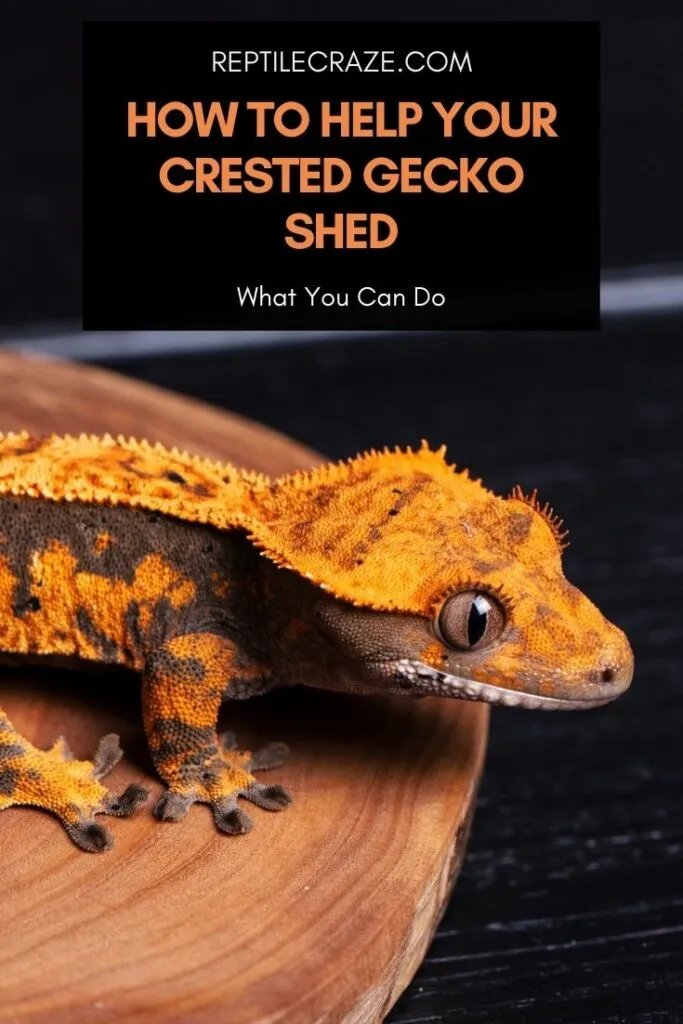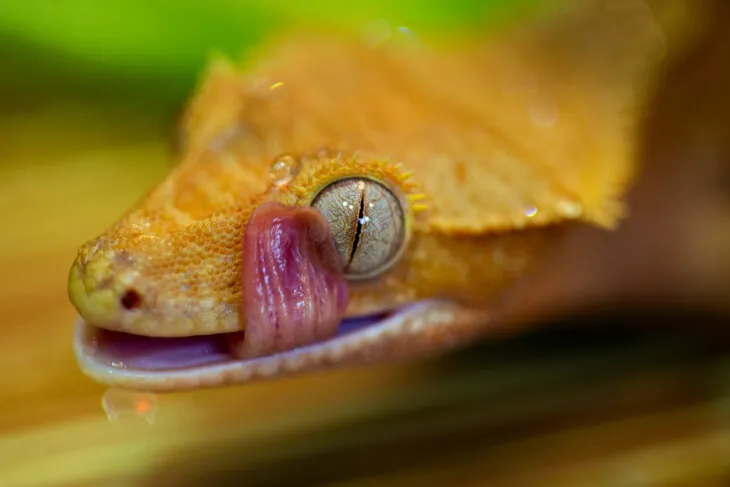
Your crested gecko must shed old skin cells regularly for its health and wellbeing. But what if it has problems during the natural shedding process, and how can you help? Is it safe to intervene, and what happens if you don’t?
In ideal conditions, crested geckos shed the outer layer of skin called the epidermis without issues. However, pet owners can help remove any stubborn skin by increasing humidity before gently picking it off. If ignored, stuck shed on the toes or tail may restrict blood flow and cut circulation.
This guide looks at the problems and offers solutions for a crested gecko’s incomplete shed known as dysecdysis. You’ll learn the safest ways to help your beloved pet through a bad shed and why it’s necessary sometimes to step in.
Table of Contents
When and How to Help Your Crested Gecko Shed
A healthy, clean shed leaves no trace of the old skin. If you notice stuck bits of dead skin, there’s a good chance there is more stuck skin that you can’t see.
Thus, it’s best to check crestie after every shed, even if it looks clean. Raising the humidity a little is a good idea if you know the lizard is about to shed its skin.
It takes a hands-on approach to remove skin stuck to the head, toes, and or tail of your crested gecko. It’s not usually a difficult task, but you need to know how to go about it the right way.
You certainly don’t want to harm your pet or draw blood. Thus, a little shedding knowledge can prevent issues and help you care for them if they occur.
Here are the best practices for safely removing dead, stuck gecko skin.
| Location | Approach A | Approach B |
|---|---|---|
| Nose | Moisten with a damp cotton swab, rub gently with fingertips or Q-tip to remove. | Gecko Sauna (see below) |
| Back | Loosen with a damp cotton swab or paper towel. Rub gently with the fingertips or a soft-bristled toothbrush to remove. | Gecko Sauna |
| Belly | Gecko Sauna | Gecko Sauna |
| Tail | Moisten with damp Q-tip or paper towel, rub gently with fingertips or soft-bristled toothbrush to remove. | Gecko Sauna |
| Eyes/lashes | Moisten with a damp cotton swab, then rub gently with fingertips or Q-tip to remove. | Gecko Sauna |
| Feet/toes | Moisten with a damp cotton swab. Gently remove using fingertips, a soft-bristled toothbrush, or Q-tip. | Gecko Sauna |
| Crest | Moisten with a damp cotton swab, then rub gently with fingertips or Q-tip to remove. | Gecko Sauna |
Is it Safe to Help Your Crested Gecko Shed?
It’s safe to remove stuck shed from your lizard’s body if you’re cautious. But you need to be patient, super gentle, and avoid using sharp objects at all costs.
Now let’s look at how to remove stuck sheds using water and raised humidity.
Warning! Water temperature above 85°F will stress your pet, and it may even suffer from heat stroke. Only use lukewarm water to soften the stuck shed.
How to Remove Stuck Gecko Shed the Right Way
First, establish where the stuck shed is on the body. Always look on the bottom of the feet and around the toes. Check the less obvious places, too, like the tip of the tail and the reptile’s private areas.
NEVER try to pull the skin off when dry. If it’s stuck, it won’t come away, and you risk hurting the animal. The trick is to use water and humidity.
Removing Stuck Shed from Feet and Eyes
Start by gently wetting the bottom of the toe(s) using a cotton swab to soften the skin. You should then be able to remove the stuck shed using BLUNT-tipped insect tweezers.
You can use a Q-tip to remove shed stuck around the eyes and eyelashes. Again, wet the cotton swab, then very, very gently rub the shed away once it softens.
If the old stuck skin proves too stubborn, move to the sauna method below.
Fun fact: Cresties are affectionately nicknamed the Eyelash Gecko due to the tiny ridges that run across the top of their eyes.
Give Your Crested Gecko a Sauna
Put the reptile in a plastic
Leave for 15–20 minutes. Both methods temporarily increase the humidity and help loosen the skin.
Note: Never leave your crested gecko unsupervised in the sauna.
When Your Gecko Refuses a Sauna
Not all geckos will cooperate with a sauna. In this case, hold a damp washcloth for your pet to walk through. The skin eventually becomes loose and removable.
Maintain Optimal Humidity Levels
You now know that humidity control is critical for your crested gecko to thrive and for optimal shedding. It’s how you maintain your lizard’s overall health and contentment (see low/high humidity tips above).
And the best way to take care of humidity is to use hygrometers, but how do you choose the right tool?
Did you know: Cresties need humidity to smell their
food and stay hydrated, in addition to making the shedding process easier?
How to Adjust Humidity Levels
Your crested gecko thrives in humidity levels between 50–60%. But you can temporarily go to 80% to help the shedding process. The easiest way to maintain humidity levels is to use moisture-retentive substrate and daily misting.
Allow the enclosure to dry out to 40%–50% before misting again to prevent the growth of mold and mildew.
When to Mist Your Crestie’s Terrarium
Ideally, you want to mist twice a day, once in the morning and again before bedtime. Alternatively, do one heavy mist each evening. Remember to use a moisture-retentive substrate with the latter approach.

Misting Devices, Sprayer Vs. Fogger
Misting is a critical part of crested gecko husbandry as it eases arduous shedding. It also helps to keep the reptile hydrated and increases the habitat’s moisture and humidity levels.
The most cost-effective way to mist is to use a simple hand sprayer. Or, consider an automated misting system if you want something less manual.
Another misting option is the internal or external fogger. These devices create a fine mist or fog within the enclosure. The type you opt for doesn’t matter. All that counts is that your misting is consistent, and the humidity stays within range.
Point to note: Fog is denser than mist and stays airborne until it evaporates, while the larger mist droplets fall to the bottom of the reptile’s enclosure.
Why You Shouldn’t Handle a Shedding Crestie
Shedding can be stressful for some crested geckos and they need a lot of energy to do it, so it’s not a good idea to handle them while it’s happening. Instead, leave them alone and allow the reptile time to focus on the shed.
Only handle your crested gecko if it needs help with shedding.
Causes and Treatments Associated with Incomplete Crested Gecko Sheds
The abnormal (incomplete) shedding of a crested gecko’s skin is called dysecdysis. Incorrect husbandry or health issues are usually to blame. This table summarizes the six common causes of dysecdysis and treatments.
| The Cause | Problem(s) | Solution(s) |
|---|---|---|
| Low humidity | An environment that is too dry is the most common cause of dysecdysis. Low humidity prevents the shedding skin from loosening, making it stubborn to remove. | Adjust and monitor the enclosure’s humidity levels using a hygrometer. Ideally, relative humidity should be between 50%–60% and up to 70%–80% during shedding. |
| High humidity | An overly moist environment can cause dysecdysis as well. Too much humidity may lead to stuck shed, fungal infection, and skin rot. | Reduce the enclosure’s humidity levels to between 50%–60%. Humidity of 70–80% should only be set during the shedding process. |
| Skin parasites | Parasitic infections can increase shedding frequency as the lizard’s body tries to eliminate the pests. However, skin parasites are rare in healthy geckos. | There’s no home fix for accelerated shedding. The only way to find the root cause and apply the right solutions is with a thorough checkup from a qualified vet. |
| Poor Nutrition | Lack of proper nutrition in the diet can lead to abnormal shedding. | Recheck your crested gecko’s diet to make sure it’s nutritionally balanced. |
| No abrasives | No or inadequate rough surfaces in the enclosure hinder or prevent stubborn dead skin removal. | Add some rough (but not sharp) surfaces to your pet’s housing. Natural |
| Hypothyroidism | Phytochemicals from certain plants (goitrogens) can suppress thyroid function. That can lead to hypothyroidism, resulting in slow growth and trouble shedding. | Avoid feeding your crested gecko plant foods too high in goitrogens. The main culprits are broccoli, cauliflower, spinach (OK in moderation), cabbage, and Kale. |
What To Do If Your Crested Gecko Doesn’t Shed At All?
If your crested gecko doesn’t shed at all it means that it is not growing properly. This could mean that your
The reason for improper growth is often Vitamin D3 or calcium deficiency. We highly recommend visiting a vet if you suspect that something is wrong with your crested gecko.
However, most geckos are known as super-shedders, though you may not always get to see it happen. See, a healthy crestie may shed all its skin at night and eat it right away.
Consuming the dead skin gives the lizard a free, easy meal. It’s also packed with vitamins and minerals needed to fuel the process all over again.
Aside from the nutritional value, eating the old skin cells hides any trace of the lizard’s presence from predators in the wild. And by sunrise, the whole thing might be over.
This speeded-up video shows a crested gecko shedding and eating its skin.
A little observation will tell when your gecko is about to replace its old skin.
What To Do If Your Crested Gecko Doesn’t Eat Its Shed Skin
It’s natural for crested geckos to eat their newly shed skin and unusual for them not to. Worried pet owners sometimes post in forums that their pet hasn’t eaten its skin.
You don’t need to act if the lizard seems healthy and behaves normally. But if it appears unwell or refuses to eat regular
Here’s a list of reasons why cresties may lose appetite before or after a shed:
- Dehydration: check clean water supply and
tank humidity levels - The temperature setting is too low
- The humidity setting is too low (less likely with a clean shed)
- Bowel impaction
- Stress (causes can vary)
- Aging (appetite loss increases with age)
- Illness, especially Metabolic Bone Disease (MBD)
If in doubt, take your reptile to the local vets for a checkup as soon as possible.
Closing Comments
If every shed is a stressful experience for your pet—and you’ve done everything you can to resolve the issues—then it’s time to visit the vet.
- Enchi Ball Python: A Unique and Stunning Morph of Python regius - March 27, 2025
- Emerald Tree Monitor: The Enigmatic Green Guardian of the Rainforest - March 26, 2025
- The Egyptian Cobra (Naja haje): A Fascinating Serpent - March 25, 2025
